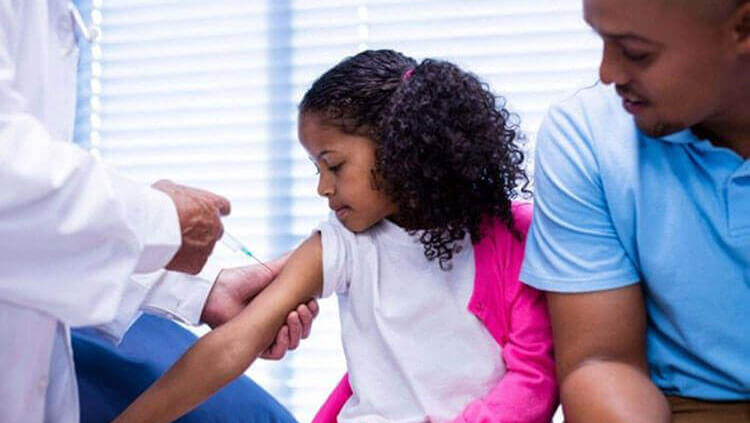How Health Professionals Can Address COVID-19 Vaccine Misinformation
Since the COVID-19 vaccine was authorized for children 12 years of age and older, I have had multiple conversations regarding the COVID-19 vaccine with my patients and their families.
During one encounter, I asked my adolescent patient and his mother about their willingness to receive the COVID-19 vaccine at his annual check-up. He hesitantly said yes while his mother sternly said no. I attempted to further explore the reasons why, but she preferred not to discuss. In another encounter when I brought up the vaccine, the mother said she was waiting for additional information to be released before she put something unknown into her or her child’s body. Of course, I understand their hesitancy, but it is often rooted in misinformation. I often think – how can we as clinicians do better to curb this lack of confidence? It is not easy, but it can be done.
I feel triumphant when families agree to receive the COVID-19 vaccine because these conversations are often challenging. Many parents are firmly set in their decision to refuse the vaccine, fueled by a barrage of negative information and perspectives. The rapid spread of ideas, images, and stories via the web, social media, and the news has led to increasing health misinformation and disinformation about the COVID-19 vaccine’s side effects and effectiveness. This is an ongoing battle that we as clinicians face every day. This misinformation lowers vaccine confidence and puts our population’s health at risk.
Despite efforts to prevent the spread of health misinformation, COVID-19 cases are increasing especially in those populations with lower vaccination coverage.1 Fifty percent of the US population has not been fully vaccinated. Within the first 2 weeks of August, there have been 1.5 million new COVID cases reported, and 7,648 deaths due to COVID-19.2, 3 Pediatric COVID-19 cases are also substantially increasing, during the week of August 5th there were 121,427 new reported cases, accounting for approximately 1 in 5 of the total reported cases that week.4
As health professionals and trusted members of the community, it’s our duty to proactively engage families, understand their point of view, correct misinformation, and serve as subject matter experts on the COVID-19 vaccine. These one-on-one conversations with families are critical but certainly are not enough. With the overwhelming amount of misinformation on social media and websites about the COVID-19 vaccine, more needs to be done to combat vaccine hesitancy. It takes efforts from multiple fronts to help address health misinformation and vaccine hesitancy. Below are recommendations to further strengthen our approach.

Image by Jack Vessels on Unsplash
Implement statewide strategies to partner with community organizations to provide appropriate resources to inform families about the benefits and known side effects of vaccinations.
Utilize postal mail, text messages, and telephone calls to communicate with families about the vaccine
Ensure these messages are linguistically and are culturally appropriate.
Create opportunities for community members to share their stories and experiences with the vaccine.
Partner with school systems to provide vaccine education materials to families.
Create vaccine clinics at schools to allow teachers, staff, students, and families to get vaccinated prior to or after the school day.
Continue to maintain walk-up vaccination sites throughout the year that remain open during the weekday and weekends.
Work with local institutions such as churches, barbershops, gyms, and community centers to meet people where they are.
Hold focus groups and listening sessions with communities to understand what approach would be most effective to reach families.
Ensure systems are in place to record most effective practices to tackle vaccine hesitancy.
Continuously monitor and evaluate vaccine confidence after the above practices have been implemented.
Continue utilizing The Vaccine Adverse Event Reporting System (VAERS), providing up to date, transparent data to the public.
With the above recommendations in place, the hope is to build vaccine confidence to prevent further cases, hospitalizations, and deaths caused by COVID-19.
References
1. CDC COVID Data Tracker. Centers for Disease Control and Prevention. https://covid.cdc.gov/covid-data-tracker/#vaccinations-cases-trends. Accessed August 16, 2021.
2. CDC COVID Data Tracker. Centers for Disease Control and Prevention. https://covid.cdc.gov/covid-data-tracker/#trends_totalcases_totalcasesper100k. Accessed August 16, 2021.
3. CDC COVID Data Tracker. Centers for Disease Control and Prevention. https://covid.cdc.gov/covid-data-tracker/#trends_totaldeaths_totalcasesper100k. Accessed August 16, 2021.
4. Children and covid-19: State-level data report. American Academy of Pediatrics. https://www.aap.org/en/pages/2019-novel-coronavirus-covid-19-infections/children-and-covid-19-state-level-data-report/. Published August 16, 2021. Accessed August 17, 2021.
Header photo from Adobe
About the author

Nailah Gallego Clemmons, MD
Pediatric Residentat Children's National Hospital



